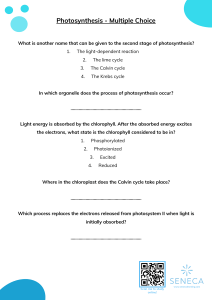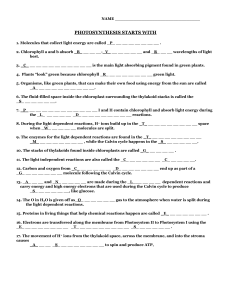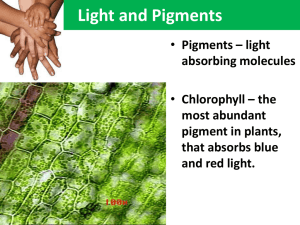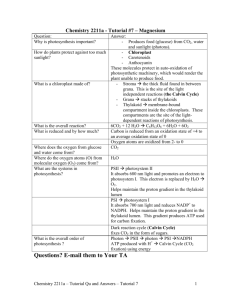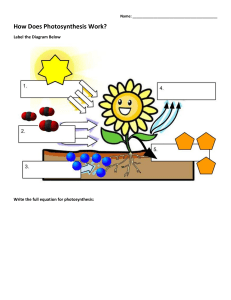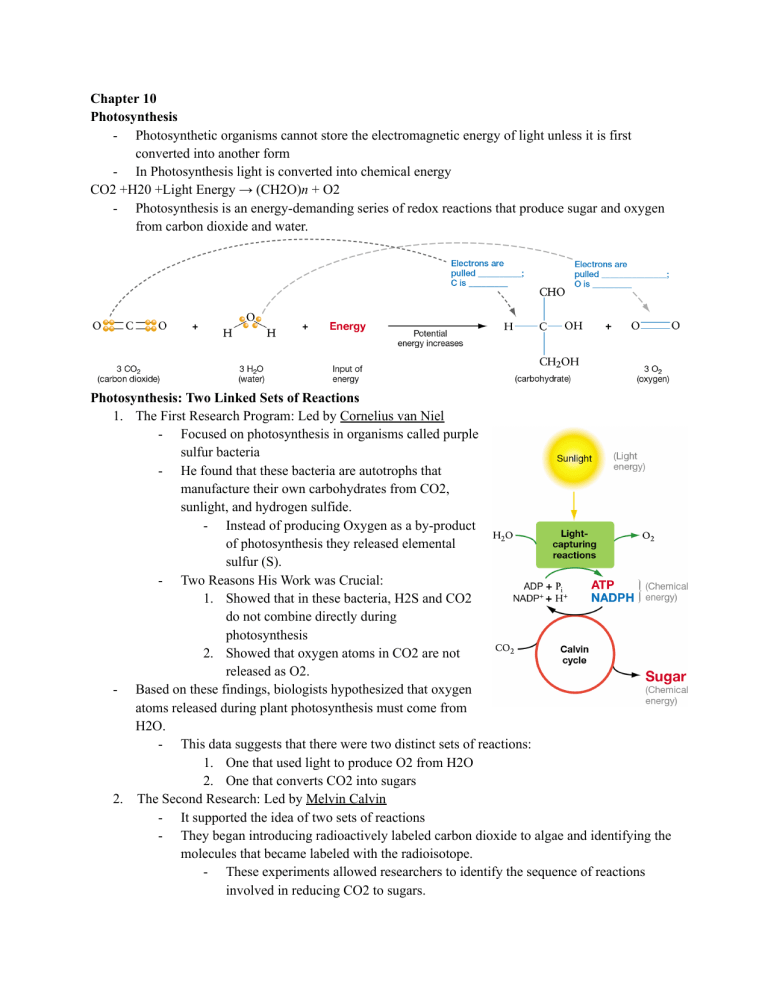
Chapter 10 Photosynthesis - Photosynthetic organisms cannot store the electromagnetic energy of light unless it is first converted into another form - In Photosynthesis light is converted into chemical energy CO2 +H20 +Light Energy → (CH2O)n + O2 - Photosynthesis is an energy-demanding series of redox reactions that produce sugar and oxygen from carbon dioxide and water. Photosynthesis: Two Linked Sets of Reactions 1. The First Research Program: Led by Cornelius van Niel - Focused on photosynthesis in organisms called purple sulfur bacteria - He found that these bacteria are autotrophs that manufacture their own carbohydrates from CO2, sunlight, and hydrogen sulfide. - Instead of producing Oxygen as a by-product of photosynthesis they released elemental sulfur (S). - Two Reasons His Work was Crucial: 1. Showed that in these bacteria, H2S and CO2 do not combine directly during photosynthesis 2. Showed that oxygen atoms in CO2 are not released as O2. - Based on these findings, biologists hypothesized that oxygen atoms released during plant photosynthesis must come from H2O. - This data suggests that there were two distinct sets of reactions: 1. One that used light to produce O2 from H2O 2. One that converts CO2 into sugars 2. The Second Research: Led by Melvin Calvin - It supported the idea of two sets of reactions - They began introducing radioactively labeled carbon dioxide to algae and identifying the molecules that became labeled with the radioisotope. - These experiments allowed researchers to identify the sequence of reactions involved in reducing CO2 to sugars. - The reaction that reduces carbon dioxide and produces sugar became known as the Calvin Cycle. - The light-capturing reactions and the Calvin Cycle are linked by a coordinated series of redox reactions. - Light-Capturing Reaction: electrons are promoted to a high-energy state by light. - This ignites a chain of electron transport steps that starts with the oxidation of water to form O2 and ends with the reduction of NADP+ to form NADPH - Calvin Cycle Reaction: the electrons in NADPH and the potential energy in ATP are used to reduce CO2 to carbohydrate. - THUS!! The Light-capturing Reactions provide high-energy molecules that drive the Calvin cycle, which in turn regenerates the ADP, Pi, and NADP+ used by the light-capturing reactions Photosynthesis Occurs in Chloroplast: - Photosynthesis only takes place in the green portions of plants. - Chloroplasts are the site of photosynthesis. - Parts of the Chloroplast: - Thylakoids: flattened, membranous sac-like structures - Grana: the interconnected sacks that thylakoids reside - Lumen: the space inside a thylakoid - Stroma: the fluid-filled space between the thylakoids and the inner membrane. - Pigments: molecules that absorb only certain wavelengths of light, the other wavelengths are reflected or transmitted. - This is how the plant appears green, due to the pigment Chlorophyll Photosynthetic Pigments Absorb Light: - When a photon strikes an object, the photon may be absorbed, transmitted, or reflected. Different Pigments Absorb Different Wavelengths of light: - There are two major pigment classes in plant leaves: 1. Chlorophylls: - designated chlorophyll a and chlorophyll b, absorbs strongly the blue and red regions of the visible spectrum. The presence of chlorophyll makes plants look green because they mostly reflect green light. 2. Carotenoids: - Absorb wavelengths in the blue and green parts of the visible spectrum. Carotenoids appear yellow, orange, or red since they reflect these colors. - Carotenoids found in plants belong to two classes: carotenes and xanthophylls. - Engelmann’s data indicated that violet-to-blue and red light are the most effective at driving photosynthesis. - Since chlorophylls absorb these wavelengths, the experiment showed that chlorophylls are the main photosynthetic pigments What Part of a Pigment Absorbs Light? - Both chlorophyll a and chlorophyll b are similar in structure: 1. Long isoprenoid “tail” - The tail interacts with proteins embedded in the thylakoid membrane 2. A “head” consisting of a larger ring structure with a magnesium atom in the middle. - Where light is absorbed - β- carotene: - Consists of an isoprenoid chain connecting two rings that are responsible for absorbing light. What is the Role of Carotenoids and Other Accessory Pigments? - Carotenoids are called accessory pigments because they absorb light and pass the energy on to chlorophyll. - Researchers have concluded that the primary function of carotenoids is to protect the plant: - Carotenoids “quench” free radicals by accepting or stabilizing unpaired electrons - As a result, they protect chlorophyll molecules from harm - When carotenoids are absent, chlorophyll molecules are destroyed by free radicals and photosynthesis stops. When Light is Absorbed, Electrons Enter and Excited State: - When chlorophyll molecules absorb a photon, the photon’s energy is transferred to bonds in the chlorophyll molecule’s head region. - In response, an electron becomes “excited” or bumps up to a higher energy state. - The electron states that are possible in a particular pigment are discrete (incremental rather than continuous) can be represented as lines on an energy scale. - Wavelengths in the ultraviolet part of the spectrum have so much energy that they may actually eject electrons from a pigment molecule and create a free radical. - Wavelengths in the infrared regions have so little energy that in most cases they merely increase the movement of atoms in the pigment, generating heat rather than exciting electrons. Photosystems: - Chlorophyll molecules work in groups not individually - In the Chloroplast thylakoid membrane, 200-300 chlorophyll molecules and accessory pigments are organized by associated proteins to form the large complex called Photosystems - Most pigment molecules in photosystems serve as light-gathering antenna pigments that guide energy towards a central reaction center. Antenna Pigments: - When antenna pigments absorb photons, the energy is added to a nearby pigment molecule, where another electron is excited in response. - This phenomenon is known as Resonance Energy Transfer - This is possible only between pigments that are able to absorb higher-energy photons to those absorbing lower-energy photons. - Once the energy is transferred, the original excited electron falls back to its ground state. Reaction Center: - When a photon or resonance energy from an antenna pigment reaches the reaction center, the energy is absorbed by one of two specialized chlorophyll molecules (together are called the special pair) - When this pigment is energized, an excited electron is transferred from the special pair pigment to an electron acceptor. - As an acceptor becomes reduced, its potential energy increases. - In the absence of light the electron acceptor does not accept electrons. It remains in an oxidized state because of the redox reaction that transfers an electron to the electron acceptor in endergonics. - But when light excited electrons in chlorophyll to a high-energy state, the reaction becomes exergonic. - Four possible fates of an electron in photosynthetic pigments that are excited by photons: 1. Be emitted in the form of light via fluorescence 2. Be given off as heat 3. Excite an electron in a nearby pigment and induce resonance 4. Be transferred to an electron acceptor in a redox reaction Photosystems I and II: - Emerson found that if the algal cells were illuminated with either red or far-red wavelengths of light, the photosynthetic response was moderate. - But if cells were exposed to a combination of both wavelengths, the rate of photosynthesis increased more than the sum of rates produced by each wavelength independently. - This phenomenon was called the Enhancement Effect - Robin Hill and Faye Bendall hypothesized that this enhancement effect resulted from two distinct types of reaction centers, each absorbing different wavelengths of light. - According to the Two-Photosystem hypothesis, the enhancement effect occurs because photosynthesis is much more efficient when both photosystems operate together. - This hypothesis is correct for cyanobacteria and the chloroplasts of eukaryotes How Does Photosystem II Work? - Converting Light Energy into Chemical Energy: 1. In Photosystem II, the action often begins when a mobile accessory structure called the Light-Harvesting Complex transmits resonance energy to an antenna pigment inside the photosystem. 2. Resonance is relayed by other antenna pigments to transfer energy to the special pair pigments in the reaction center. 3. At this point, another types of pigments molecule, called pheophytin, comes into play - Pheophytin: identical to chlorophyll except the pheophytin lacks a magnesium atom in its head region. - Unlike other pigments, pheophytin does not become excited by photons or resonance energy- it accepts excited electrons from the reaction center special pair chlorophylls. - The redox reaction between pheophytin and special pair pigments is the key step in transforming light energy into chemical energy. - - - - - - 4. Immediately after an excited electron is transferred to pheophytin, the oxidation reaction center special pair pigment becomes an incredibly strong electron acceptor. In both structure and function the thylakoid ETC is similar to the components in the mitochondrial ETC: - Structurally: - The photosystem II and mitochondrial ETC both contain quinones and cytochromes. - Functionally: - The redox reactions that occur in both ETCs result in protons being actively transported from one side of an internal membrane to the other. The resulting proton-motive force drives ATP production via ATP synthase. Recall the molecule plastoquinone (PQ): - A quinone similar to ubiquinone in the ETC of cellular respiration - It is a small hydrophobic molecules that can transport two electrons between molecules - Since PQ is lipid soluble, it is free to move within the thylakoid membrane When PQ is reduced by picking up two electrons from photosystem II, it carries them through the membrane to the lumen side of the thylakoid and delivers them to molecules with a higher redox potential in the cytochrome complex. - In this way PQ shuttles electrons from Photosystem II to the cytochrome complex. Similar to the mitochondrial ubiquinone, PQ also picks up protons when it becomes reduced. - After being oxidized by the cytochrome complex, PQ drops off the protons in the thylakoid lumen. - The protons transported by PQ result in a high concentration of protons in the thylakoid lumen The pH in the thylakoid reaches 5 while the pH of the stroma hovers around 8, this difference of 3 units means that the concentration of H+ 1000 times higher in the lumen than in the stroma. - Also the stroma becomes negatively charged relative to the thylakoid lumen. The net effect of electron transport is a large proton electrochemical gradient. - This gradient results in a proton-motive force that, in turn, drives H+ out of the thylakoid lumen and into the stroma. - Flow down the electrochemical gradient is an exergonic process that is coupled to the endergonic synthesis of ATP from ADP and Pi. - Photophosphorylation: the synthesis of ATP in the chloroplast. - Difference between phosphorylation(in chloroplast) and Oxidative phosphorylation(in the mitochondria): - In the mitochondria: ATP is exported and fuels many different cellular processes - In the chloroplast: the ATP remains within the organelle and is used for the production of carbohydrate. Photosystem II Obtains Electrons by Oxidizing Water: - 2H2O → 4H+ 4e- + O2 - This reaction is referred to as “splitting” water - It supplies electrons for Photosystem II and is catalyzed by a complex of enzymes that are physically integrated into photosystem II. - Since Oxygen is very electronegative this reaction is highly endergonic. - When excited electrons are removed from the photosystem II reaction center pigments, the redox potential of the oxidized pigments becomes so strong that enzymes can pull electrons from water, pass them to the pigments, and release protons and oxygen. - How energy flows through photosystem II and the ETC: - Light → Antenna pigments → Reaction center (electrons from water splitting are accepted here) → Pheophytin → ETC → Proton gradient → ATP synthase. How Does the Photosystem I Work? - In order to reduce one NADP+, two electrons must be excited by photons. - Steps of Photosystem I: 1. Antenna pigments absorb photons and pass the energy to the photosystem I reaction center 2. Two electrons(one for each photon in step 1) are excited in reaction center chlorophyll molecules. 3. The reaction center pigments are oxidized, and the excited electrons are passed through a series of carriers inside the photosystem, then to Ferredoxin, and then to the enzyme NADP+ Reductase 4. NADP+ Reductase transfers the two electrons and a proton to reduce NADP+ and form NADPH. The Z Scheme: Photosystems II and I Work Together: 1. This process starts when photons excite electrons in photosystem II antenna pigments 2. When the energy in the excited electrons is transferred to the reaction center, a special pair of chlorophyll molecules, each called P680, passes excited electrons to pheophytin. 3. From there the electrons are gradually stepped down in potential energy through redox reactions among a series of quinones and cytochromes. - Each reduced PQ picks up protons from the stroma and transfers them to the lumen after being oxidized by the cytochrome complex. 4. ATP synthase uses the resulting proton-motive force to phosphorylate ADP, creating ATP 5. Once electrons reach the end of the cytochrome complex, they are passed to a small diffusible protein called Plastocyanin - Each reduced plastocyanin diffuses through the lumen of the thylakoid and donates one electron to an oxidized reaction center pigment in photosystem I. 6. The electrons that flow into P700 are eventually excited and transferred to the protein ferredoxin, which passes electrons to the enzyme that catalyzes reduction of NADP+ to NADPH. - For each O2 molecule produced by photosystem II, 4 electrons have been transferred along the Z scheme to make 2 molecules of NADPH. The Enhancement Effect: - When chloroplasts are illuminated with wavelengths in the red portion of the spectrum, only photosystem II can run at a maximum rate. - The overall rate of the Z scheme is moderate because photosystem I’s efficiency is reduced. Noncyclic Electron Flow Between Water and NADP+ - The electrons that pass from water to NADP+ move through a chain of redox reactions in a linear fashion, referred to as Noncyclic Electron Flow - Chloroplast and Mitochondria differ in how electron potential energy changes between the primary electron donor and the terminal electron acceptor - In Mitochondria: ETC electron potential energy starts high and then steadily drops as the electrons are transferred to the terminal electron acceptor, which has the lowest potential energy. - In Chloroplast: the electron donor (H2O) has much lower potential energy than the reduced terminal electron acceptor (NADPH) Cyclic Electron Flow Recycles Electrons and Drives Photophosphorylation: - During Cyclic Flow, electrons excited in photosystem I are transferred back to the electron transport chain, generating ATP through photophosphorylation instead of reducing NADP+. - Cyclic electron flow coexists with Noncyclic flow and produces additional ATP to meet the energy demands for manufacturing sugars from carbon dioxide. How Do Cells Capture Carbon Dioxide? - CO2 is unable to diffuse directly into the plant along a concentration gradient due to the plant's waxy coating called cuticle. - The lipid bilayer prevents water from evaporating out of tissues, but it also prevents gasses like CO2 and O2 from crossing the plasma membrane - Instead CO2 gets into photosynthesizing tissues through specialized pores. - The surface of a leaf is dotted with openings bordered by two distinctive shaped cells called Guard Cells - The opening between these paired cells is called a pore and the entire structure is a STOMA. - The Stoma is where COS diffuses into the plant and O2 diffuses out. The Calvin Cycle Fixed Carbon: - Carbon Fixation: - The addition of carbon atoms from inorganic carbon dioxide to an organic compound. - The word “fix” is appropriate because the process converts(or fixes) CO2 gas to a biologically useful form. - Carbon fixation is a redox reaction: - The carbon atom in CO2 is reduced by attaching to another carbon. - Calvin and co-workers' results suggested that 3PGA was the first product of carbon fixation. - Carbon dioxide reacted with the same unknown molecule to produce 3-phosphoglycerate. - Calvin did more research to find the additional initial reactant and found that it was the 5-Carbon compound Ribulose Bisphosphate (RuBP) The Discovery of Rubisco: - All photosynthetic organisms that use the Calvin Cycle to fix carbon require the CO2-fixing enzyme Ribulose-1,5 bisphosphate carboxylase/oxygenase(Rubisco) - The Rubisco enzyme is roughly cube-shaped and consists of 16 polypeptides that form eight active sites where CO2 is fixed. - Despite the large number of active site Rubisco is a slow enzyme - Also O2 and CO2 have to compete at the enzymes active sites, which slows the rate of CO2 reduction. - Since photorespiration requires energy and releases fixed CO2, it “undoes” photosynthesis. - When photorespiration occurs the overall rate of CO2 fixation declines. Mechanisms for Increasing CO2 Concentration: - When conditions are hot and dry stromata must close and CO2 and O2 transport stops - meaning that photosynthesis slows and photorespiration increases. First Mechanism: C4 Pathway - - The C4 pathway does not replace the Calvin Cycle; it serves as an additional fixation step. - C4 pathways actually fix CO2 using both pathways- to a 3-Carbon compound by an enzyme called PEP Carboxylase(C4) and to RuBP by Rubisco(C3) - PEP Carboxylase: found commonly in Mesophyll Cells near the surface of leaves - Rubisco: found in Bundle-Sheath Cells that surround the vascular tissue in the interior of the leaf. Hal Hatch and Roger Slack proposed a four-step model to explain how the CO2 is fixed to form a 4-Carbon molecule: 1. PEP Carboxylase fixes CO2 to phosphoenolpyruvate. 2. The 4-Carbon molecules that result are transported to bundle-sheath cells via channels called plasmodesmata. 3. The 4-Carbon molecules are broken down to release CO2 molecules. Bundle-sheath cells are less permeable to gases, so CO2 concentrations rise and promote carbon fixation by Rubisco to form 3PGA. - This step initiates the Calvin Cycle - - 4. The 3-Carbon compound remaining after CO2 is released is returned to the mesophyll cell to regenerate ATP. Although the C4 Pathway requires additional ATP to fix CO2 for the Calvin Cycle, the energy expenditure is justified by the increased efficiency of photosynthesis in conditions where stomata are mostly closed to prevent dehydration. Second Mechanism: CAM Plants - This is a CO2 concentrator that acts as an additional, preparatory step to the Calvin Cycle. - It generates a 4-Carbon organic acid in its first CO2 fixation step. - Unlike the C4 Pathways , CAM occurs at a different time than the Calvin Cycle does, not in a different place - CAM occurs in Cato and other species that routinely keep their stomata closed on hot, dry days. At night when conditions are cooler and more humid, CAM plants open their stomata and take in huge quantities of CO2 - The CO2 is temporarily fixed to organic acids and stored in the central vacuoles of the photosynthetic cells. - During the day, when the stomata are closed, these acids are processed in reactions that release the CO2 and feed the Calvin Cycle. The C4 and CAM pathways function as CO2 pumps. They minimize photorespiration when stomata are closed and CO2 cannot diffuse in directly from the atmosphere - Difference between C4 and CAM Pathways: - C4: stockpiles CO2 by fixing and storing organic acids in cells WHERE rubisco is not active - CAM: stores CO2 WHEN rubisco is inactive - C4: the reaction catalyzed by PEP carboxylase and rubisco are separated in SPACE - CAM: the reactions are separated in TIME Captured CO2 is Reduced to Make Sugar: - The reactions that produce sugar from CO2 are not triggered directly by light. - Instead they depend on the ATP and the NADPH produced by the light-capturing reactions The Calvin Cycle is a 3-Step Process: 1. Fixation Phase: - The Calvin Cycle begins when CO2 reacts with RuBP. This phase fixes carbon and produces 2 molecules of 3PGA, which is a phosphorylated 3-Carbon organic acid 2. Reduction Phase: - The 3PGA is phosphorylated by ATP and then reduced by accepting electrons from NADPH as the phosphate is removed. - The product is the phosphorylates 3-Carbon sugar glyceraldehyde-3-phosphate (G3P). - Some of G3P that is synthesized is drawn off to produce other organic molecules, like Glucose. 3. Regeneration Phase: - The rest of the G3P keeps the cycle going by serving as the substrat for the third phase in the cycle: reactions that use the additional ATP in the regeneration of RuBP. - All 3 phases take place in the stroma of the chloroplast. In the Calvin Cycle: each mole of CO2 requires the energy from 3 moles of ATP and 2 moles of NADPH to fix it and reduce it to sugar. How is Photosynthesis Regulated? - The presence of light triggers the production of proteins required for photosynthesis - When sugar supplies are high, the production of proteins required for photosynthesis is inhibited, but the production of proteins required to process and store the sugars is stimulated - Rubisco is activated by regularity molecules that are produced when light is available, but inhibited in the conditions of low CO2 availability- when photorespiration is favored. What Happens to the Sugar That is Produced by Photosynthesis? - Gluconeogenesis: the use of G3P to produce the monosaccharide glucose - Glucose combines with fructose to form the disaccharide sucrose - When photosynthesis is taking place slowly , almost all the G3P that is produced is used to make Sucrose. - Sucrose is water soluble and readily transported to other parts of the plant. - If sucrose is delivered to rapidly growing parts of the plant, it is broken down to fuel cellular respiration and growth. - When photosynthesis is proceeding rapidly and sucrose is abundant, the glucose molecules are polymerized to form Starch. - Starch production occurs inside the chloroplast and Sucrose synthesis takes place in the cytosol. - Starch acts as a temporary sugar-storage product. - At night, the starch that is stored in leaf cells is broken down to glucose molecules. Which is then fed into cellular respiration or used to manufacture sucrose for transport to other parts of the plant.
